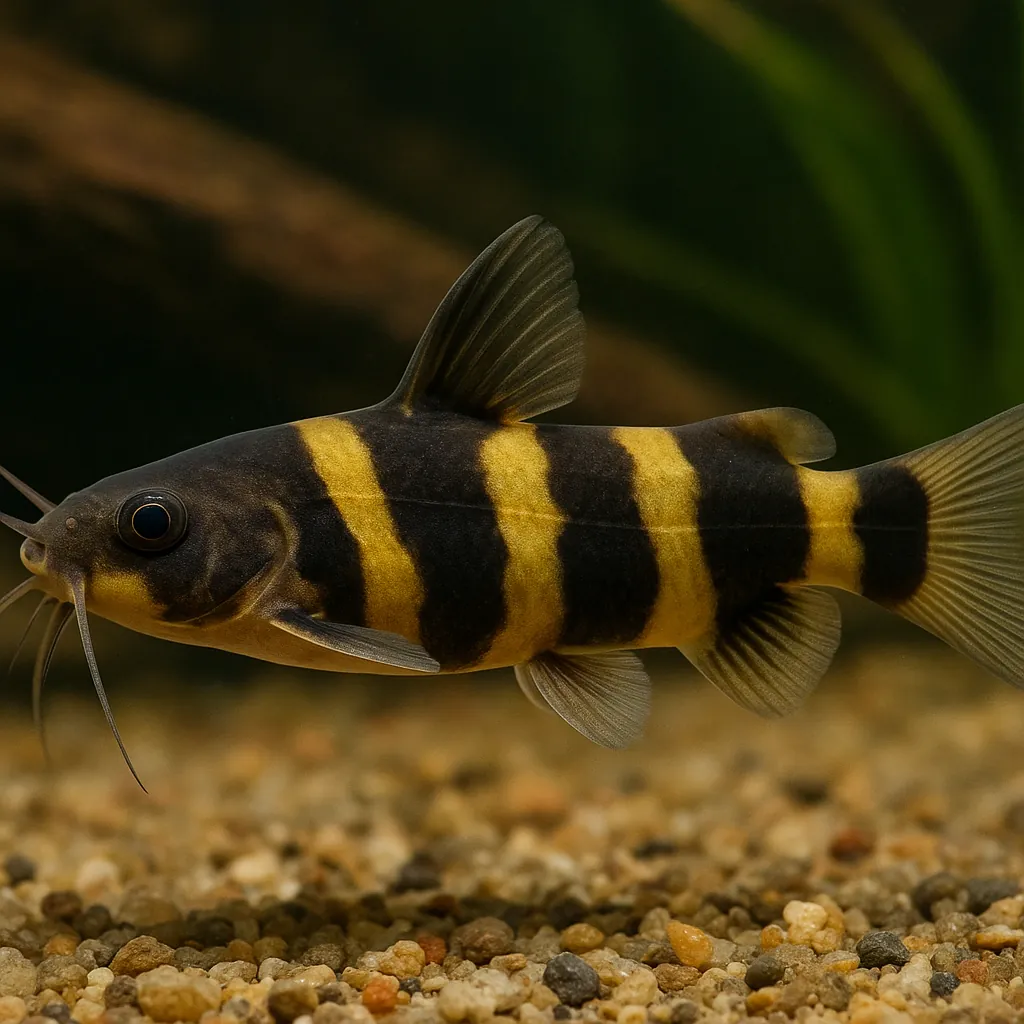
Bumblebee catfish
Introduction
The Bumblebee Catfish (Microglanis iheringi) is a captivating freshwater species cherished by aquarists for its striking black and yellow banding, reminiscent of a bumblebee. This small, nocturnal catfish is renowned for its peaceful demeanor and adaptability, making it an excellent choice for both novice and intermediate fishkeepers. With proper care, the Bumblebee Catfish can thrive in a well-maintained aquarium, offering enthusiasts the joy of observing its unique behaviors and interactions.
Care and Environment
Providing optimal care for the Bumblebee Catfish involves replicating its natural habitat and meeting its specific needs.
What is the minimum tank size required for a Bumblebee Catfish?
A minimum tank size of 76 liters (20 gallons) is recommended for a single Bumblebee Catfish. For each additional catfish, an extra 38 liters (10 gallons) should be provided to ensure ample space and reduce territorial disputes.
What are the ideal water parameters for Bumblebee Catfish?
Maintaining stable water conditions is crucial. The preferred temperature range is between 21°C and 25°C (70°F to 77°F), with a pH of 6.5 to 7.5, and water hardness between 8 to 12 dGH. Consistency in these parameters helps prevent stress and promotes overall health.
How should the tank be decorated to suit Bumblebee Catfish?
Incorporate a soft substrate like sand or fine gravel to protect their delicate barbels. Provide ample hiding spots using driftwood, rocks, and caves, as these catfish are nocturnal and seek shelter during daylight hours. Live plants can be added to create shaded areas and enhance the natural feel of the aquarium.
Effective filtration is essential to maintain water quality, but ensure the flow is moderate to mimic their natural riverine habitats. While they prefer dim lighting, using subdued or adjustable lighting can help create a comfortable environment. Feeding should consist of a varied diet, including high-quality sinking pellets, live or frozen foods like bloodworms and brine shrimp, and occasional vegetable matter. Feeding at night aligns with their nocturnal nature and encourages natural foraging behaviors.
Origin and Habitat
The Bumblebee Catfish is native to the freshwater rivers and streams of South America, particularly in Venezuela and Colombia. These environments are characterized by soft, acidic waters with moderate flow, abundant vegetation, and a substrate composed of sand and fine gravel. Seasonal variations, including fluctuations in water levels and temperature, influence their natural behaviors and breeding patterns.
Temperament and Compatibility
Bumblebee Catfish are generally peaceful and can coexist with a variety of tank mates. However, their nocturnal nature and tendency to prey on smaller fish during nighttime feeding should be considered when selecting companions.
Are Bumblebee Catfish aggressive towards other fish?
No, they are typically peaceful but may consume very small fish or fry during their nocturnal feeding activities. It's advisable to avoid housing them with tiny species that could be seen as prey.
What are suitable tank mates for Bumblebee Catfish?
Compatible tank mates include similarly sized, peaceful species such as Corydoras catfish, Bristlenose Plecos, Rainbow Sharks, Dwarf Gouramis, and Kuhli Loaches. These combinations help maintain a harmonious community aquarium.
Do Bumblebee Catfish prefer to be kept in groups?
While they can be kept singly, providing a group can encourage more natural behaviors. Ensure the tank is spacious enough to accommodate multiple individuals without overcrowding.
Interesting Facts
The Bumblebee Catfish exhibits several intriguing traits that enhance its appeal to aquarists.
Why are they called Bumblebee Catfish?
The name derives from their distinctive black and yellow banding, which resembles the coloration of a bumblebee.
Are Bumblebee Catfish active during the day?
They are primarily nocturnal, often hiding during daylight hours and becoming more active at night. However, they can be enticed to emerge during the day, especially during feeding times.
Is breeding Bumblebee Catfish in captivity common?
Breeding in home aquariums is rare, with few documented cases. Specific conditions, such as providing caves or tunnels and maintaining dim lighting, may encourage spawning, but success is uncommon.
Sources
All information in this article has been gathered from the following reputable sources:
Overview
Recommended Tank Size 30.1 Gallons (for a pair) |
Minimum Group Size 1 |
Minimum Tank Volume 20.1 Gallons |
Maximum Adult Length 2.8 inches |
Average Adult Length 2.4 inches |
Shoaling (6+ required) No |
Preferred Water Type Freshwater, soft, acidic |
Temperature Range (°C) 21–25 |
pH Range 6.5–7.5 |
Water Hardness (dGH) 8–12 |
Typical Lifespan (years) 4 years |